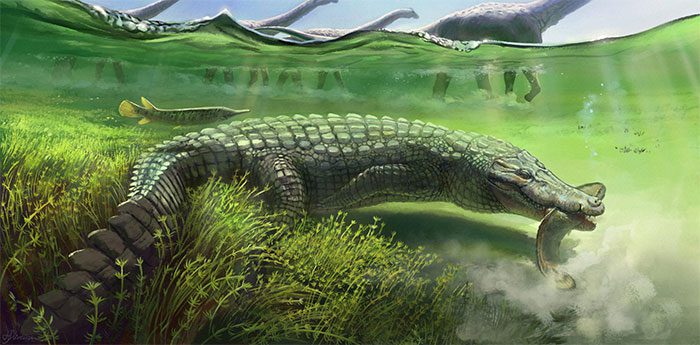Titanochampsa iorii, a name that evokes the Titans, the giants of Greek mythology, has been designated for a terrifying creature found in São Paulo, Brazil.
According to Sci-News, this monster unearthed in the Monte Alto region of São Paulo is an ancient, colossal, and previously unknown crocodilian that coexisted with the mighty titanosaur (the largest dinosaur on Earth) and the carnivorous abelisaurid dinosaurs.
Together with the aforementioned creatures from the Cretaceous period, this gigantic crocodile dominated the land that is now Brazil between 72 and 66 million years ago.

Newly identified monster crocodile in Brazil – (Photo: Julia d’Oliveira).
A research team led by Dr. Thiago Fachini from the University of São Paulo reported that this creature could grow up to 6 meters long in life and had an incredibly strong bite. It lived in environments ranging from arid to semi-arid, where small swamps were scattered.
“Both the large size of Titanochampsa iorii and its hypothesized powerful bite are consistent with an amphibious lifestyle, including ambush behavior, as seen in most modern crocodiles, and align with its possible relationship to other reptiles,” Dr. Fachini stated.
The first fragments of its fossilized body were discovered in 1987, but it wasn’t until recently that scientists gathered enough data to classify it as a new species and provide a brief description.
“Due to its large size and the disjointed nature of the fossils, the parts of Titanochampsa iorii were initially labeled as part of the skull of a lizard,” the authors noted. Only recently did they uncover abnormalities and deduce that it belonged to an ancient crocodile.
The skull still retains a scale fragment at the side, which aids in reconstructing its “appearance” more easily.
In addition to representing a previously lesser-known group from the Cretaceous of Brazil, Titanochampsa iorii contributes to a better understanding of the evolutionary aspects of crocodiles and the group it represents, which still has descendants today, while most other ancient crocodile groups from the Cretaceous have gone extinct.
This research was recently published in the scientific journal Historical Biology.


















































